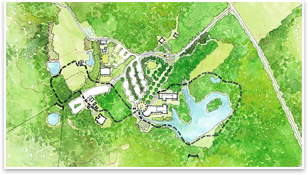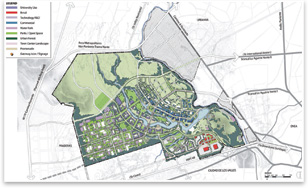
Market Flexibility Is Keeping These Firms Above Water
Architecture firms are growing adept in incremental architecture. Rather than building from the ground up or remaking a site in one fell swoop, many firms are involved with more multi-phase and long-term planning projects. "What's happening now is that projects are handled in pieces," says Joseph Brancato, AIA, a managing principal at Gensler in New York. Phasing may allow clients more easily to finance the job, causing architects to analyze individual components of a potentially larger scope.
Allen Washatko, AIA, cofounder of the Wisconsin-based firm, identifies adaptive re-use and historic preservation as another area of growth. TKWA is known for ecologically progressive renovations and expansions and has just completed a sensitive addition to Frank Lloyd Wright's Unitarian Meeting House in Madison. But commercial office buildings are also prime candidates for eco-smart renovation. Given the major restructuring of financial services firms and the reduced costs of construction, Gensler has recently received numerous commissions to upgrade and "reposition" commercial skyscrapers to attract future tenants. Presupposing a market recovery, one such client who commissioned the firm to do a feasibility study decided to proceed straight into design and construction to take advantage of low construction costs.
Good market for government experience
Even within the U.S., "everyone is extending their reach," says Scott Erdy, AIA, cofounder of Erdy McHenry Architecture in Philadelphia. "We are looking for ways to participate in other markets." The young firm has made a name for itself in Philadelphia, winning awards for the Independence Mall Cafe, NoLi Housing, and a residence hall at Drexel University, among other projects. But over the past few months the architects have sought and won commissions from institutions outside their home market, for example from Cornell and Syracuse Universities. Not everything has changed since fall 2008. After all, budget limits and contextual considerations are nothing new. In the words of Michael Kerwin: "What's going on is very serious, but if you have good fundamentals, continue building relationships as opposed to single projects, and are designing for the long term, those are still your most important assets." |
||
Copyright 2009 The American Institute of Architects. All rights reserved. Home Page |
||
news headlines
practice
business
design
recent related
› Design Culture Adapts to Shrinking Budget
The AIA is gathering resources to help members through the economic downturn, which are available through the Navigating the Economy page on AIA.org.
Captions:
1. Cincinnati Nature Center core site plan designed by TWKA, comprising 30 site and building improvements to be implemented over 15 years.
2. Exterior rendering of an 11-story New York office building, originally built in 1913 as the Auerbach Chocolate factory, now being renovated and "repositioned" by Gensler for a global marketing/communications tenant.
3. Site plan of AECOM's 2500-acre, mixed-use Laguna Caren project near Santiago, Chile, an example of the firm's heightened focus on international projects.
4. Erdy McHenry Architecture's proposed 49,000-sq.-ft. Vertical Screen office building in Pennsylvania. Despite the economic downturn, the client remained committed to the sustainable design strategy, which includes geothermal heat exchange and a prefabricated wood shell with integrated photovoltaic.

 Summary:
Summary: Responding to the long-term vision and short-term budget constraints of the Cincinnati Nature Center, the Kubala Washatko Architects (TKWA) has created a site development plan to be implemented gradually over 15 years. The initial plan includes site and road improvements, pedestrian trails, day-camp pavilions, and schematic building renderings for a new visitor center and preschool building. The center, whose endowment declined last year, can then use those renderings in its private fundraising campaign and application for federal stimulus funding. "Unfortunately, we've had to postpone the new buildings," says Bill Hopple, director of the center, "but we can proceed with discrete improvements."
Responding to the long-term vision and short-term budget constraints of the Cincinnati Nature Center, the Kubala Washatko Architects (TKWA) has created a site development plan to be implemented gradually over 15 years. The initial plan includes site and road improvements, pedestrian trails, day-camp pavilions, and schematic building renderings for a new visitor center and preschool building. The center, whose endowment declined last year, can then use those renderings in its private fundraising campaign and application for federal stimulus funding. "Unfortunately, we've had to postpone the new buildings," says Bill Hopple, director of the center, "but we can proceed with discrete improvements." The well-established ecological benefits of renovation and rehabilitation increasingly dovetail with economic incentives. The stimulus package that President Obama signed in February will provide federal grants and tax breaks for projects that improve energy efficiency and transportation infrastructure, according to Urban Land Institute President Richard Rosan. [
The well-established ecological benefits of renovation and rehabilitation increasingly dovetail with economic incentives. The stimulus package that President Obama signed in February will provide federal grants and tax breaks for projects that improve energy efficiency and transportation infrastructure, according to Urban Land Institute President Richard Rosan. [ While much recession news focuses on downsizing, some architects are taking the quiet time as an opportunity to dream bigger, travel farther, and get more deeply involved with community endeavors. AECOM recently began work on a vast series of projects on behalf of the Libyan government. The contract comprises planning and development of housing, infrastructure, and tourism-related sites across the country. Kerwin says the firm is stretching the limits of its practice by focusing more resources on projects in Libya, Chile, Brazil, and Mexico. Meanwhile, Gensler recently organized a public conference on sustainable development in the capital of Costa Rica. This conference was the culmination of a year-long research project conducted within the firm's internal think tank, the "Gensler University" program.
While much recession news focuses on downsizing, some architects are taking the quiet time as an opportunity to dream bigger, travel farther, and get more deeply involved with community endeavors. AECOM recently began work on a vast series of projects on behalf of the Libyan government. The contract comprises planning and development of housing, infrastructure, and tourism-related sites across the country. Kerwin says the firm is stretching the limits of its practice by focusing more resources on projects in Libya, Chile, Brazil, and Mexico. Meanwhile, Gensler recently organized a public conference on sustainable development in the capital of Costa Rica. This conference was the culmination of a year-long research project conducted within the firm's internal think tank, the "Gensler University" program.